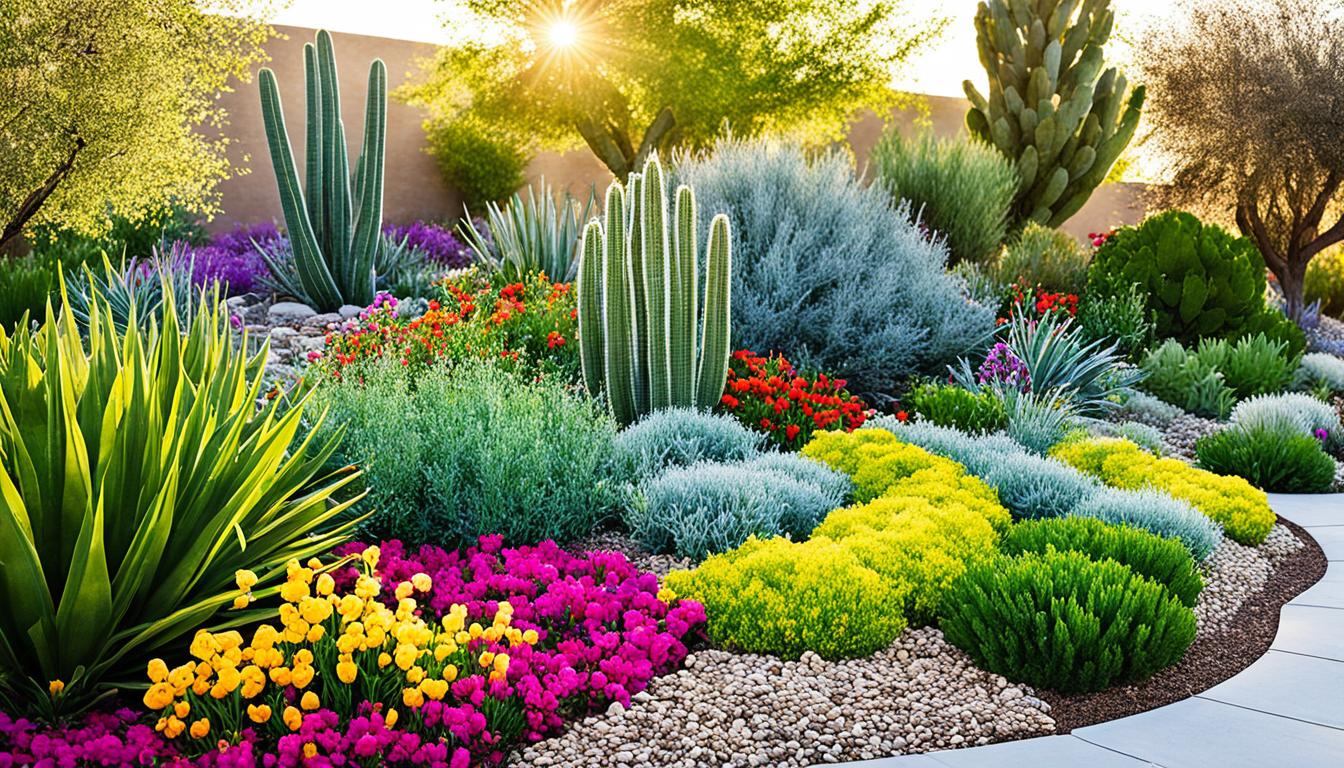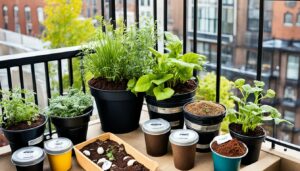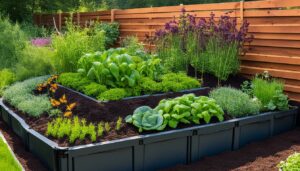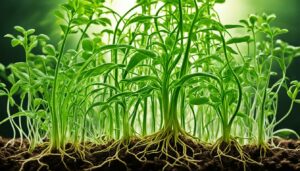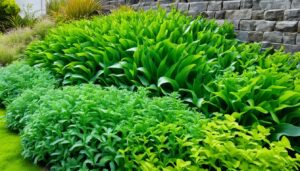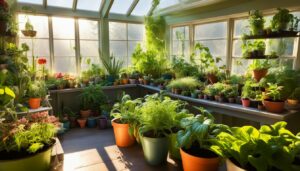Did you know that a single square foot of green, lush lawn can evaporate up to a gallon of water on a hot day? In the face of this startling fact, the importance of water-saving gardening in drought-prone areas has never been clearer. As the climate pendulum swings with ever-greater unpredictability, eco-friendly gardening is no longer just a trend – it’s a necessity. With each drop of water becoming more precious, gardeners are turning to sustainable landscaping and low-water gardening techniques to create verdant spaces that thrive under the sun’s relentless gaze.
Key Takeaways
- Sustainable landscaping is crucial in conserving water and thriving within eco-system limitations
- Water-saving gardening helps maintain lush gardens even in regions faced with limited water resources
- Low-water gardening techniques offer practical solutions for durable and beautiful outdoor spaces
- Drought-prone areas can support diverse plant life with the right water-efficient practices and species selection
- Investing in soil health through composting and proper amendments can greatly reduce the need for frequent watering
- Strategic use of mulching and drip irrigation systems maximizes moisture retention while minimizing waste
Embracing Xeriscaping: The Foundation of Water-Saving Gardening
As the need for sustainable living practices becomes increasingly urgent, xeriscaping emerges as a pivotal solution for eco-friendly gardening practices. By prioritizing the variety and placement of drought-resistant flora, xeriscaping has become synonymous with environmentally conscious gardening. Not only does it offer an aesthetically pleasing alternative to traditional landscaping, it also champions water-efficient gardening practices.
Moving away from moisture-reliant grasses to embracing drought-tolerant perennials is a transformative step that ultimately leads to a significant reduction in water usage. This is especially pertinent when applied to areas with high visual impact, such as the house front. Rather than large, thirsty lawns, envision a tapestry of vibrant xeriscaping plants that deliver an eco-friendly message with every bloom.
For those wanting to blend style with sustainability, the integration of hardscape elements can be equally transformative. The allure of a well-placed sculpture or the pragmatic beauty of gravel and stone pavers ensures that your garden radiates charm without exceeding water budgets. It’s in these details that water-efficient gardening practices find their fullest expression.
The art of xeriscaping is not a compromise; it’s an evolution towards smarter, more responsive gardening that respects the bounds of our environment while delighting our senses.
Strategic use of organic mulches can be yet another essential technique. These purposeful layers retain moisture, regulate soil temperature, and reduce the evaporation that thwarts lesser gardens. Furthermore, selecting plant species with silver or gray foliage, renowned for their resilience in arid conditions, defines a xeriscape that’s both rugged and radiant.
- Replace high-water lawns with drought-resistant ground covers
- Integrate hardscape elements for decoration and functionality
- Opt for porous materials to reduce water runoff
- Use mulches to decrease evaporation rates
- Choose plant species with high drought tolerance for robust growth
| Xeriscaping Element | Benefits | Examples |
|---|---|---|
| Drought-Resistant Plants | Saves water, low maintenance | Succulents, Lavender, Sage |
| Organic Mulch | Retains moisture, adds nutrients | Straw, Bark chips, Compost |
| Hardscaping | Reduces water usage, adds structure | Pavers, Gravel, Decorative Rocks |
| Porous Pathways | Minimizes runoff, filters rainwater | Permeable Concrete, Pea Gravel |
| Silver/Grey Foliage | Reflects heat, drought-resistant | Lamb’s Ear, Dusty Miller |
Incorporating these xeriscaping principles not only serves the environment but also bolsters the beauty and perpetuity of your garden. By reimagining our landscapes to embrace a more water-conscious approach, gardeners can forge a future where splendor and sustainability grow hand in hand.
Incorporating Drought-Tolerant Plants and Eco-Friendly Practices
The genesis of eco-friendly gardening undoubtedly revolves around the use of drought-tolerant plants and sustainable landscaping concepts. By harnessing the power of nature’s most resilient species and integrating water-efficient systems, gardeners can foster lush landscapes that thrive in dry conditions. Let’s delve into the best practices and techniques essential for creating an environmentally conscious garden.
Identifying and Growing Drought-Resistant Varieties
Plant selection is critical in low-water gardening techniques. Species such as ornamental grasses, lavender, and Russian sage, which flourish with scant water supply, are perfect for sustainable landscapes. Embracing native plants is particularly beneficial; they’re naturally equipped to handle the local climate with minimal hydration.
Efficient Water Management and Irrigation Techniques
Water-efficient gardening practices, such as using a drip irrigation system, maximize water usage by delivering it directly to plant roots, minimizing evaporation. Mulches serve to retain soil moisture and decrease watering needs. Choosing light-colored, glazed pots can also help reduce water loss.
Strategies for Soil Improvement to Enhance Water Retention
Soil that retains water efficiently is an ally in a drought-prone garden. The incorporation of organic matter like compost or coconut coir into the soil not only improves its structure but also increases water retention, facilitating better hydration for plants even in arid conditions. For container gardens, biochar and hydrogel can be mixed with the soil to enhance its capacity to retain water.
Designing a Landscape that Conserves Water
Careful landscape design is the final piece of the puzzle. Densely planted flora shields the soil from the sun, cutting down evaporation rates. Plant groundcovers to effectively act as living mulch, and opt for plants with reflective, gold-tinted foliage to amplify the glow of the garden with minimal water use. Choosing gravel and similar inorganic mulches also assists in reducing runoff and promoting the conservation of moisture in the soil.
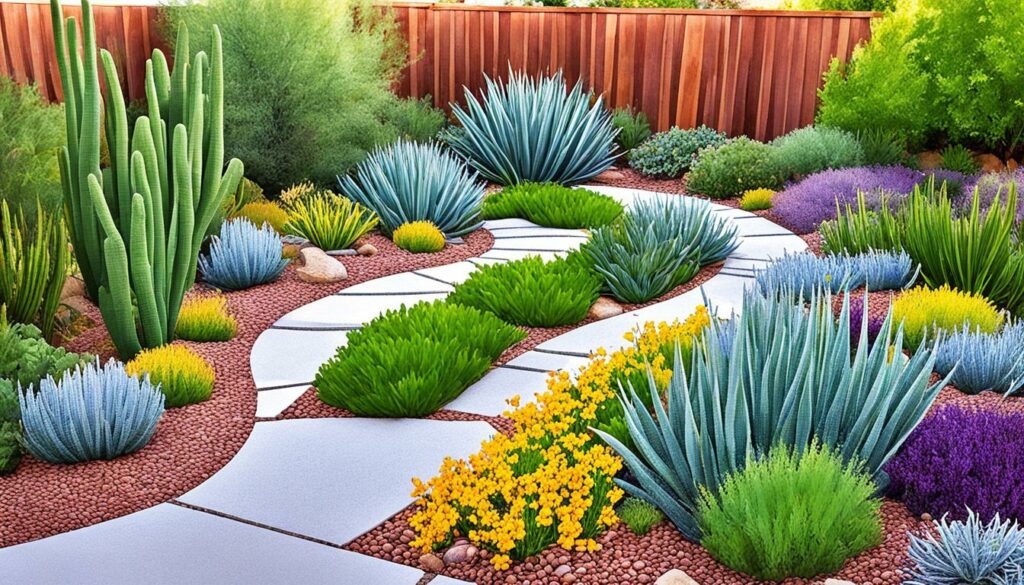
Together, these components of water-saving gardening form a cohesive framework that supports the health and vibrancy of gardens in even the driest climes. Sustainable does not have to mean barren; with thoughtful planning and execution, a sustainable landscape can be as opulent and diverse as any traditional garden.
Conclusion
In summary, the impact of water-saving gardening is significant, particularly in regions facing water scarcity. Do you reside in a drought-prone area and aspire to nurture a thriving garden that conserves water? Embrace the synergy of drought-tolerant plants, soil optimization, and cutting-edge irrigation methodologies. Not only are these elements foundational for sustainable landscaping, but they also form the bedrock of eco-friendly gardening. By incorporating the principles of xeriscaping, gardeners forge an alliance with the environment, fostering spaces that cherish the delicate balance between nature and nurture.
The transformation of gardens into water-saving havens is an art that harmonizes aesthetics with sustainability. Integrating drought-tolerant species into the garden palette is not merely about surviving arid conditions but also about supporting and sustaining local biodiversity. The innovative adaptation of xeriscaping goes beyond just planting Indigenous flora—it’s about creating a narrative of resilience and beauty that flows throughout the landscape.
As our discourse on water-wise gardening culminates, let us remember that each drop conserved is a lifeline extended to these ecological oases. By thoughtfully employing the practices discussed, our gardens can remain vibrant sanctuaries of life, irrespective of the aridity of the climate. Indeed, sustainable landscaping is less about the limitations imposed by the environment and more about the boundless possibilities that innovative gardening techniques can unlock.

